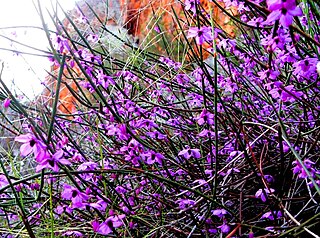
Tetratheca is a genus of around 50 to 60 species of shrubs endemic to Australia. It is classified in the botanical family Elaeocarpaceae, now known to encompass the family Tremandraceae, which the genus originally belonged to. It occurs throughout extratropical Australia, and has been recorded in every mainland state except the Northern Territory.
Tetratheca paynterae, also known as Paynter's Tetratheca, is a species of plant in the quandong family that is endemic to Australia. There are two recognised subspecies.
Tetratheca deltoidea, also known as granite tetratheca, is a species of plant in the quandong family that is endemic to Australia.
Tetratheca similis is a species of plant in the quandong family that is endemic to Australia.
Tetratheca retrorsa is a species of plant in the quandong family that is endemic to Australia.
Tetratheca remota is a species of plant in the quandong family that is endemic to Australia.
Tetratheca paucifolia is a species of plant in the quandong family that is endemic to Australia.
Tetratheca fasciculata, also known as Cronin's Tetratheca, is an extinct species of plant in the quandong family that was endemic to Australia.
Tetratheca setigera is a species of plant in the quandong family that is endemic to Australia.
Tetratheca affinis is a species of plant in the quandong family that is endemic to Australia.

Tetratheca virgata is a species of plant in the quandong family that is endemic to Australia.
Tetratheca confertifolia is a species of flowering plant in the quandong family that is endemic to Australia.
Tetratheca pilata is a species of plant in the quandong family that is endemic to Australia.
Tetratheca phoenix is a species of flowering plant in the quandong family that is endemic to Australia.
Tetratheca exasperata is a species of flowering plant in the quandong family that is endemic to Australia.
Tetratheca nephelioides is a species of plant in the quandong family that is endemic to Australia.
Tetratheca erubescens is a species of flowering plant in the quandong family that is endemic to Australia.
Tetratheca pubescens is a species of flowering plant in the quandong family that is endemic to Australia.
Tetratheca efoliata is a species of flowering plant in the quandong family that is endemic to Australia.

Tetratheca aphylla, also known as the Bungalbin Tetratheca, is a species of flowering plant in the quandong family that is endemic to Australia.



